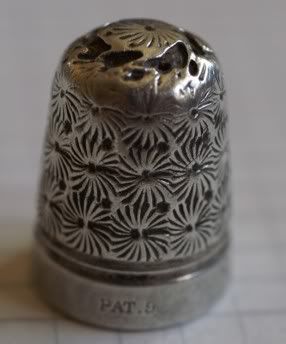Page 1 of 1
A Charles Horner Dorcas Thimble
Posted: Mon Apr 24, 2006 7:37 pm
by Granmaa
Here is a Dorcas thimble by Charles Horner. He invented this sort of thimble to further protect the finger which was often pricked by needles penetrating the soft silver. To combat this, he sandwiched a layer of steel between two layers of silver. However, because of this steel core, he was prevented from putting the sterling hallmark on his pieces, and this is why I'm asking for a date on this thimble. I'm not sure if this is the daisy pattern or the Princess May: the swirl on top seems quite unusual.
Granmaa

.
Posted: Tue Apr 25, 2006 5:41 am
by carling
The Dorcas thimble was first launched in 1884 (patent 8954, June 14, 1884). Early Dorcas thimbles were not marked as such but were stamped PAT (and occasionally Patent) and size number. In 1905 the improved Dorcas was introduced and the word DORCAS, CH and a size number first appeared on the thimbles.
Your thimble was therefore made between 1884 and 1905 and is the daisy pattern. The Princess May pattern thimble (not always easy to tell the difference between it and the regular daisy pattern) was stamped with the Registered Design Number (RD 210800) and was introduced on April 18, 1893. It is known by this name because it was used on a gold thimble given to Princess Victoria Mary of Teck (known as Princess May). The daisies are arranged in squares and so it differs slightly from the regular daisy pattern design.
The "swirl" on the top of your thimble is damage. It is quite well used.
Regards/carling
.
Posted: Tue Apr 25, 2006 5:49 am
by carling
This is the Princess May version with RD Number:

Posted: Tue Apr 25, 2006 6:40 am
by Granmaa
Thanks for that Carling.
Miles
.
Posted: Tue Feb 02, 2010 2:57 pm
by dognose
Dorcas thimble advert from 1908.

Note the 'Horner's Patent'.
Trev.
Re: A Charles Horner Dorcas Thimble
Posted: Fri Jul 05, 2013 5:48 pm
by dognose
The "Dorcas " thimble, is, we think (although apparently a very small matter), destined to play an important part in the household economy of the future. Most people are aware of the want of durability of the ordinary silver thimble, and many have experienced the pains of pricks received from needleheads going through holes in partially worn out thimbles. The invention under notice, which is the patent of Mr. Horner, of 23, Northgate, Halifax, is practically everlasting in this respect, as it consists of two parts of silver and an intermediate one of steel, which are all struck up together and form a light and durable thimble that is sure to be in strong demand as soon as its properties become generally known to the sewing community.
Source: The Watchmaker, Jeweller and Silversmith - 1st November 1887
Trev.


